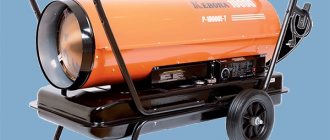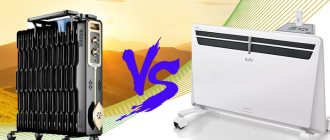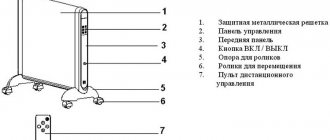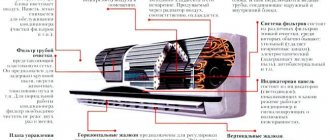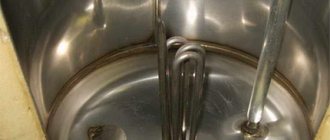General requirements for space heating
There are clear criteria by which you can immediately evaluate the capabilities of a particular electrical appliance. For example, for an unheated room these indicators look like this:
- for an area of up to 6 sq.m – 550 Watt;
- from 7 to 9 – 750 Watt;
- from 10 to 20 – from 1000 to 1750.
To heat a room with an area of more than 20 square meters, you need a heater with a power of 2 kW or higher. We will try to determine which class to choose based on a comprehensive analysis of the capabilities of the devices.
What is an oil heater
The oil heater is a sealed housing made of stainless metal alloys. In high-quality products, these are aluminum-containing compounds; cheap Chinese products are guilty of using simple steel, while relying on tightness (the radiator does not rot from the inside) and an external protective coating.
It’s worth noting right away that the best combination of price and service life will have a product in the middle and high price range.
The operating principle of an oil heater is quite simple:
- inside a sealed metal case, which consists of separate blocks (for a large area of contact with air), there is transformer oil;
- after turning on the device, the electric heating element or a group of them heats the coolant;
- when the oil temperature reaches the value set using the regulator, heating stops;
- after the oil has cooled by a certain number of degrees, the heating elements are turned on again and return the coolant to the temperature specified by the user.
The oil cooler is self-sufficient. Depending on the volume, the warm-up time may vary. But after the device is in operating mode, it shows excellent characteristics of economy and efficiency. The heating elements are turned on for a short time, the radiator almost always has the same temperature.
What's better?
Oil radiators are capable of heating large areas, and their safety level is high enough that this equipment can be turned on for several days without additional control.
Such devices operate silently, they are reliable and environmentally friendly, which also speaks in favor of oil radiators. But still, a fan heater or an oil radiator, which is better? This question can be answered if you know the advantages of the device, among which stand out:
- The rate of heating of the surrounding space,
- Small overall dimensions, which means mobility,
- Use at any time of the year as a heating or cooling element,
- Relatively low cost.
So in the end, you need to determine whether a fan heater or an oil heater is better, depending on the area of the room, financial capabilities and period of use of the device. Oil radiators are convenient to use in rooms where excessive noise is not desired and a high degree of safety is required. This could be a bedroom or a children's room.
How does a fan heater work?
The fan heater is also not complicated. Here the heat source is a red-hot coil or thin metal plates.
When air is blown, it heats up and enters the volume of the room. The general operating principle is similar to the mechanics of an oil cooler:
- at start, the fan heater reaches its technical maximum;
- voltage is supplied to heat the heat-producing metal parts until the thermostat records the average temperature in the case specified by the user;
- There is no complete cessation of energy consumption - the fan runs constantly.
But there are also key differences between the two classes, which will be mentioned later. Here we note the main thing: the fan heater is strongly tied to the air flow; if it is impossible to supply the full volume for blowing, the device will turn off due to internal overheating protection, releasing noticeably less heat into the room than stated by the manufacturer. A covered fan heater will not be able to “survive”, unlike an oil radiator.
Round one. Comparison in terms of price and convenience
The first thing the user evaluates is the ease of use of the electrical device and its safety. For the average potential owner, this assessment is enough to decide what is better to buy - a fan heater or an oil heater. In this case, energy consumption and the cost of long-term operation are not taken into account. Therefore, let's make a direct comparison.
- Noise level. Pure loss of the fan heater. Although modern models are equipped with horizontal fans or screw turbines, the noise level is significant. The fan heater does not stop, this contributes to the development of fatigue, decreased concentration and attention of a person. In addition, as use progresses, the device becomes dirty and begins to make more and more noise.
- Switching modes. To be as precise as possible, both classes of heaters make clicking and crackling noises. But with a high-quality oil heater, uncomfortable noise occurs only when, for example, it was stored upside down or lying down. Once installed in a vertical position, the gurgling and crackling time is short, the device quickly enters the mode and the only sound that is emitted is the soft start-up clicks made by the thermal relay. The fan heater clicks loudly with relay groups much more often. In this case, a high voltage is switched, the sound is distinct and quite loud, in addition, in many models the fan motor speed simultaneously increases.
- Overall reliability. Device failures play an important role, and here the fan heater is an outright outsider. It has two temperature protection groups, the heaters are subject to constant burnout, the fan group is subject to depletion of lubricant, and the regulators are subject to oxidation and drying out. A good oil cooler has only two bottlenecks. A bimetallic plate in the regulator, which will oxidize or burst after ten years, as well as a universal temperature and pressure fuse - in case of any problems associated with overloads and loss of oil pressure, it blocks the operation of the device and must be replaced.
- Safety of use. The fan heater is lightweight and is often not equipped with a position sensor. It is easy to brush away, drop, break. However, there is no guarantee that it will stop working. And this causes an additional possibility of fire of objects, short circuits, and electric shocks. The oil cooler is durable, heavy, solid. It is difficult to drop it, damage it, or touch other objects with it. But the heated elements of the fan heater are covered with grilles, and you can touch the oil radiator heating block with temperatures up to 90 degrees. Therefore, in terms of safety of use, both classes have their own niches, where each of them is able to win.
- Microclimate. The fan heater plays with a loud crash. It burns oxygen. In addition, dust is constantly sucked into it, burns in a spiral and emits an unpleasant odor. The oil cooler has no problems. Modern models equipped with a humidification unit can improve the microclimate, including saturating the air in the room with aromatic oils.
- Humidifier attachment can be used to dry clothes. Comparisons can continue for a long time. The undoubted advantages of oil radiators and the gains in many areas are visible during operation. But when choosing a model in a store, the fan heater wins; it is cheap, lightweight, compact, and you can buy a model of any power.
Features of oil heaters
Oil-type heaters are also called radiators. They are easy to use (just plug them in), produce a lot of heat and are not susceptible to electrical faults. Traditionally they are used in houses and apartments.
Structurally, the radiator consists of the following elements:
- A reservoir with a heating element that is filled with mineral oil.
- Rheostat for temperature control.
- Horizontal position sensors (at a significant angle of inclination, the equipment simply turns off).
- Case parts.
- Compartment for storing the power cable.
The advantages of these devices are:
- Low cost.
- Ease of movement (modern models are equipped with wheels).
- Quiet operation.
- Does not dry out the air.
The disadvantages are low safety, the need for control, large dimensions, high energy consumption and the risk of oil spillage.
Last round. Indicators of long-term operation
To understand what is better, let’s consider the cost of long-term operation.
- Power consumption. Equal in power, a fan heater and an oil heater differ radically in monthly energy consumption. The first one has a constant minimum level, the fan does not turn off. The second one works for a precisely defined amount of time, which is lower, the lower the level of heat loss in the room. But the oil cooler performance indicators are stable. And over time, the fan heater begins to consume more and more - the heating elements become clogged, become thinner, and you have to work longer in heating mode to create a certain amount of heat.
- Heating quality. It has been a proven fact many times that an oil radiator performs best when heating a room continuously. After entering operating mode, the air in the room is stable, as is the average temperature of the oil in the heater. At the same time, more output is required from the fan heater - constant air movement and a drop in humidity do not contribute to the formation of a feeling of warmth. It takes much longer to warm up the room.
- Heating rate. There is a common belief that a fan heater warms up a room faster to a minimum comfortable temperature. In a pure comparison of classical classes of devices, this is true. But today, manufacturers of oil radiators offer models with plate blowing, which literally turn on the turbo mode until the room reaches a comfortable temperature, not inferior to fan heaters.
- Life time. As mentioned above, the number of components subject to constant wear in a fan heater is many times higher. Complete failure, after which there is no point in carrying out repairs, occurs relatively quickly. For an oil heater, the concept of repair being pointless can only exist in the case when the radiator is simply rotten. And for models in the mid- and high-price range, this is theoretically achievable only after decades.
As can be seen from the above, in terms of the cost of long-term operation, the oil heater is in the lead by a huge margin. It just works and works and works. The service life before failure is very long, the cost of repairs is low. A fan heater that constantly works to the point of wear and tear cannot boast of even comparable operating time before the need for repair arises.
Let's sum it up
By purchasing a heater, you get:
- uniform heat distribution in the room
- no noise from the device
- possibility of heating a certain area of the room
But be prepared for the fact that it is unprofitable to use heaters in empty and large rooms, since these devices require considerable time to uniformly heat even a small area.
By choosing a fan heater, you gain the following features:
- high room heating rate
- long operating time
- fast heating function for large industrial premises
- affordable cost of the heating device
Please note that due to the powerful air flow.
created by the fan heater. The device is not recommended for use in rooms where there may be people who are allergic to dust and other small particles. It is not easy to choose between these devices and the functions that distinguish them. It all depends on your preferences and goals. But we hope that we have successfully helped you understand this topic. If you still have questions, you can call our consultants and get all the missing information.

